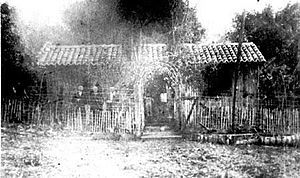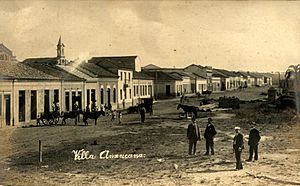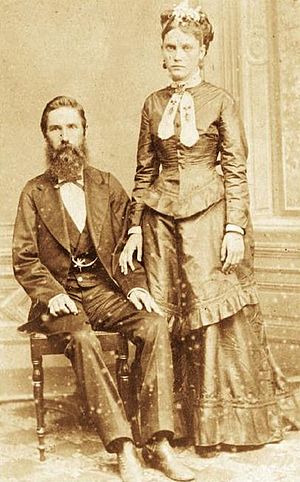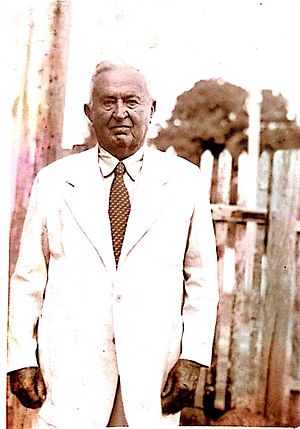Confederados facts for kids
| Os Confederados | |
|---|---|
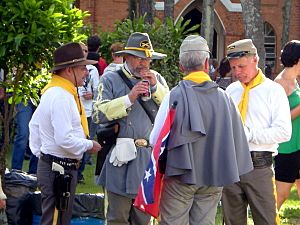
Os Confederados at Festa Confederada
|
|
| Total population | |
| c. 260,000 | |
| Regions with significant populations | |
| Americana · Santa Bárbara d'Oeste | |
| Languages | |
| American English · Portuguese | |
| Religion | |
| Protestantism · Irreligion |
Os Confederados (which means "The Confederates" in Portuguese) are the descendants of people from the Southern United States who moved to Brazil after the American Civil War (1861-1865). They left their homes during a time called Reconstruction, when big changes were happening in the Southern states.
About 20,000 Americans, mostly from the Southern states, moved to Brazil after the war. They were invited by Emperor Dom Pedro II of Brazil, who wanted their help to grow more cotton in his country. Most of these families first settled in the state of São Paulo. They even founded a city called Americana, which was once part of Santa Bárbara d'Oeste. Today, you can find descendants of Confederados all over Brazil.
A very important place for Confederado culture is the Campo Cemetery in Santa Bárbara d'Oeste. Many of the first Confederates were buried there. Since they were Protestants and couldn't be buried in Catholic cemeteries, they created their own. This was the first cemetery in Brazil not for Catholics or native people. The Confederado community also has a Museum of Immigration in Santa Bárbara d'Oeste. It tells the story of immigrants in Brazil and how they helped the country.
The descendants of these families still keep their history alive through a group called the Fraternity of American Descendants. This group works to preserve their special mixed culture. They also have an annual festival called the Festa Confederada. This festival helps raise money for the Campo Cemetery. At the festival, you might see Confederate flags, people dressed in traditional Southern clothes like Confederate uniforms and hoop skirts, and enjoy food and music from the American South with a Brazilian twist.
Contents
History
After the American Civil War, many people from the Southern states, especially plantation owners, did not want to live under the new rules. The war had ended slavery, which changed how farms worked, and African Americans gained the right to vote, which changed politics. These Southerners were used to growing cotton with the help of enslaved people. So, some of them looked for other places where they could continue their old way of life.
Brazil was one of the few places in the world that still allowed slavery at that time. The New Orleans Daily Picayune newspaper wrote in 1865 that people who loved the idea of slavery thought Brazil would be a good place for them.
The Brazilian Emperor Dom Pedro II saw a chance to help his country. The war had caused problems for cotton production in the Southern United States. England and France, who bought a lot of cotton, needed new suppliers. The Emperor wanted to increase Brazil's cotton production. So, he encouraged cotton farmers from the former Confederacy to move to Brazil.
Moving to Brazil
Even before the war ended in 1865, people were talking about moving to Brazil. But they didn't know much about the country. After the war, many emigration companies were formed to help people move. Some representatives were sent to Brazil to check out the land, weather, and what the Emperor was offering.
In November 1865, the state of South Carolina formed a group to help people settle in Brazil. They sent Major Robert Meriwether and Dr. H. A. Shaw to investigate. When they returned, they reported that some people had already bought land and settled there. They also mentioned that enslaved people were cheap.
Many Southerners who accepted the Emperor's offer had lost their enslaved people during the war. They didn't want to live under the American Constitution after the 13th Amendment ended slavery. They also didn't expect the Southern economy to get better under the new rules. Brazil did not ban slavery until 1888, much later than the United States. The Confederates were the first organized Protestant group to settle in Brazil.
Americana & Santa Bárbara d'Oeste
On December 27, 1865, Colonel William Hutchinson Norris from Alabama arrived in Rio de Janeiro. In 1866, William and his son Robert traveled to São Paulo to look for land. They were offered free land in a marshy area, which they refused. They continued to Campinas and eventually found a large plain.
The Norrises bought land near the Ribeirão Quilombo river. This area was part of Santa Bárbara d'Oeste at the time, but it is now the city of Americana. Colonel Norris started teaching local farmers how to grow cotton and use new farming tools. The plow he brought from the United States was so new and interesting that many students paid him to learn. He wrote to his family that he made US$5,000 just from teaching. In mid-1867, the rest of his family and many relatives arrived.
Many farms were started by these American immigrants. They grew and processed cotton. Trade grew, especially after 1875, when a railroad station was built nearby. Because so many immigrants lived there, the village around the station became known as "Vila dos Americanos" or "Vila Americana." This village grew into the city of Americana.
The Carioba factory was also built around this time by an American engineer, Clement Willmot, and his Brazilian partners. This factory was very important for the growth of Americana. Education was a top priority for American families. They set up schools on their properties and hired teachers from the United States. The teaching methods they used were so good that Brazilian schools later adopted them.
Religious services were held on the farms by pastors who traveled between different American communities. In 1895, the first Presbyterian Church was founded in the village. Since the Catholic Church did not allow non-Catholics to be buried in their cemeteries, American immigrants buried their dead near their farmhouses. This became known as the Campo Cemetery. It is now a tourist spot in Santa Bárbara d'Oeste. Even today, descendants of these families are buried there. They gather there for religious ceremonies and parties around the old chapel.
Amazonas and Pará
Jason Williams Stone, an American immigrant, moved to Brazil before the American Civil War. He became a very rich tobacco and rubber farmer in the Amazonas region. His large farms were called Colonia Stone. Many of his descendants still have the "Stone" surname and live in Manaus and Itacoatiara.
The city of Santarém in the state of Pará also received families fleeing the American Civil War. The Riker family was among the first to arrive. David Afton Riker, a descendant, wrote a book called The Last Confederate in the Amazon, telling the story of this migration. The Confederates and their descendants became important in the business and politics of the region.
It is believed that about 20,000 U.S. citizens entered Brazil between 1865 and 1885, seeking a new home.
Descendants of Os Confederados

The first generation of Confederates mostly stayed within their own community. But by the third generation, many families had married Brazilians or people from other countries. Over time, Confederate descendants started speaking Portuguese more and saw themselves as Brazilians. As the area around Santa Bárbara d'Oeste and Americana grew, many moved to bigger cities for jobs. Today, only a few families still live on the land their ancestors owned. Most descendants are now spread across Brazil. They keep their group's main office at the Campo Cemetery, which also has a chapel and a memorial.
Descendants connect with their history through the American Descendant Fellowship, a group that works to preserve their unique culture. They also have an annual "Festa Confederada" in Santa Bárbara d'Oeste to raise money for the Campo Cemetery. At the festival, people wear Confederate flags and uniforms, and enjoy Southern American food and dances. The descendants feel a connection to the Confederate flag, even though they see themselves as fully Brazilian. Many have even traveled to the United States to visit Civil War battlefields or the places where their ancestors lived.
The Confederate flag in Brazil does not have the same political meaning as it does in the United States. In 1972, when then-Governor Jimmy Carter visited the region, the city of Americana even put the Confederate flag on its coat of arms. However, most of the Italian-descendent population later removed it from the city's official symbol. During his visit, Carter also visited Santa Bárbara d'Oeste and the grave of his wife Rosalynn Carter's great-uncle at Cemitério do Campo. He noticed that Confederate descendants sounded and looked just like Southerners from the United States.
Today, the Campo Cemetery in Santa Bárbara d'Oeste, with its chapel and memorial, is a special place. Most of the first Confederate immigrants were buried there. As Protestants, they were not allowed to be buried in local cemeteries by the Catholic Church, so they had to create their own. The community of descendants also helped create the Museum of Immigration in Santa Bárbara d'Oeste. This museum tells the story of U.S. immigration to Brazil.
The American immigrants brought many new things to Brazil. These included foods like pecans, Georgia peanuts, and watermelon. They also brought new tools like the iron plow and kerosene lamps. They introduced modern dentistry, modern agriculture, and even the first blood transfusion. They also started the first non-Catholic churches (Baptist, Presbyterian, and Methodist). Some Southern American foods, like chess pie, vinegar pie, and southern fried chicken, became part of Brazilian culture. The immigrants also started public schools and made sure their girls received an education, which was not common in Brazil at the time.
Statistics
- American immigration to Brazil by State up to January (1867)
| State | Immigrants |
|---|---|
| São Paulo | 800 |
| Espírito Santo | 400 |
| Rio de Janeiro | 200 |
| Paraná | 200 |
| Pará | 200 |
| Minas Gerais | 100 |
| Bahia | 85 |
| Pernambuco | 85 |
| Total | 2,070 |
About 20,000 Southerners from 12 Southern states, like Arkansas, Alabama, and Mississippi, chose to move to Brazil. They preferred the Brazilian wilderness to living under "Yankee" rule after the American Civil War.
U.S. ancestry in Brazil
- Number of American descendants by state
| State | Descendants |
|---|---|
| São Paulo | 100,490 |
| Espírito Santo | 50,258 |
| Rio de Janeiro | 25,220 |
| Paraná | 25,000 |
| Pará | 24,800 |
| Minas Gerais | 12,610 |
| Bahia | 10,686 |
| Pernambuco | 10,000 |
| Total | 260,000 |
Confederado quotes
Some quotes from Confederates and their descendants:
"...My father was hurt in a battle in Virginia and sent home. He recovered and went back to the war. He was put in prison and then released. He returned home and went back to the battle field again. "...In those days of shocking terror, rebuilding and staying there became impossible. Crimes happened daily around us, and we could do nothing..."
"Our farm was beautiful, with many acres, good houses, horses, and cattle. We had a corn mill and machines for processing cotton... The Brazilian government welcomed us very well. They hosted us at the Immigrant Hotel, giving us shelter and food. It was my job to explain that we were not just immigrants. We were refugees. War refugees."
"I have sugar cane, cotton, pumpkins, squash, five kinds of sweet potatoes, Irish potatoes, cornfield peas, snap beans, butter beans, okra, tomatoes, and a good chance at tobacco. I have many different fruits on my land. I have made enough to live well and am happier than others."
"I remember when I was 4 years old, I got lost in a textile factory. I couldn't tell people anything because I only spoke English," said an engineer and third-generation descendant. "I didn't learn Portuguese until I started school."
"They came here because they felt their 'country' had been invaded and their land taken," said a great-granddaughter of the McKnight family who moved from Texas. "To them, there was nothing left there. So, they came here to try to create what they had before the war." She added, "I grew up listening to the stories. They were angry and bitter. When they talked about moving here, the war, leaving their homes, it was always a very sensitive topic for them."
See also
 In Spanish: Os Confederados para niños
In Spanish: Os Confederados para niños



